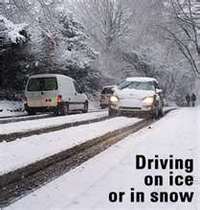Drivers Could be Stuck in an Emergency if They Only Have Junk in their Trunk
 |
New survey reveals only one in 10 drivers keep essential emergency supplies in their vehicle
BLOOMINGTON, IL, Jan. 16, 2013: Finding yourself stranded in your car due to treacherous conditions like snow, ice, poor visibility and slick roads only to discover you have junk in the trunk, rather than the necessary roadside emergency supplies, can place you and your family in jeopardy.
According to a new survey by State Farm and KRC Research, more than 60 percent of drivers had some sort of "junk" (non-emergency supplies) in their trunkranging from extra clothes and shoes to used food or drink containers. While 99 percent of drivers had at least one emergency supply in their vehicle, such as spare tire or jumper cables, a mere nine percent carried all the essential emergency roadside supplies, including:
- Jumper cables
- Spare tire
- Hazard triangle/road flares
- Flashlight
- First aid kit
- Water
- Blanket
"Even on a relatively short trip, you can find yourself stranded for several hours. From icy waters splashing up on Lake Shore Drive in Chicago to fog covering the Golden Gate Bridge in San Francisco, it's important to be prepared," said Robert Medved, safety expert, State Farm. "These new findings highlight the importance of having the right emergency equipment so people can safely get back on the road faster."
Medved also recommends drivers check at least twice a year to ensure the equipment is in working order. This means spare tires are properly inflated, first-aid supplies are current, all other supplies are fully stocked, and the cell phone charger is compatible with either a power outlet or an USB port in your car. Communication capability can be the number one lifeline in some roadside emergency cases.
How Your Junk Stacks Up:
New survey findings also revealed that sedan drivers (63 percent) are less likely to carry emergency supplies compared to SUV and truck owners (75 percent and 73 percent respectively). Also, only two in five drivers said they check that the emergency supplies in their vehicle are working at least twice a year, in line with what State Farm recommends.
Advice for Drivers:
State Farm encourages responsible driving every day of the year, and especially during cold weather months when inclement weather is more common. If you are stranded on the road, follow these tips:
- Pull off the highway (if possible), turn on your hazard lights and use a road flare or reflectors to signal attention.
- If you have a cell phone, call 911 and describe your location as precisely as possible. Follow any instructions from the dispatcher.
- Remain in your vehicle so help can find you.
- Run your vehicle's engine and heater about 10 minutes each hour to keep warm.
- Open a downwind window slightly for ventilation and clear snow from the exhaust pipe to prevent carbon monoxide poisoning.
- Don't waste your vehicle's battery power. Balance electrical energy needs -- lights, heat and radio-- with supply.
- At night, turn on an inside light when you run the engine so help can see you.
- Keep emergency supplies like road flares, a flashlight, blanket, windshield scraper, jumper cables, spare tire and a first aid kit in your vehicle or trunk at all times.
- Keep your fuel tank at least 1/2 full at all times during bad weather.
For additional information and emergency roadside tips, visit Worst Case Winter Driving
Methodology
This survey was designed and conducted by KRC Research. Interviews were conducted by an omnibus telephone (landline and cell phone) survey between December 6 and December 9, 2012. The landline and cell phone combined sample is a dual frame sampling design. This means that the sample is drawn from two independent non-overlapping sample frames--one for landlines and one for cell phones.
In all, 1,010 U.S. adults, age 18 and older, were interviewed. 659 interviews were from the landline sample and 351 interviews from the cell phone sample. Of those respondents interviewed, 895 qualified as drivers of a car; and the results of this survey are based on this sample. The data were weighted by age, sex, geographic region, race, and education to ensure reliable and accurate representation of the national population age 18 and over.


